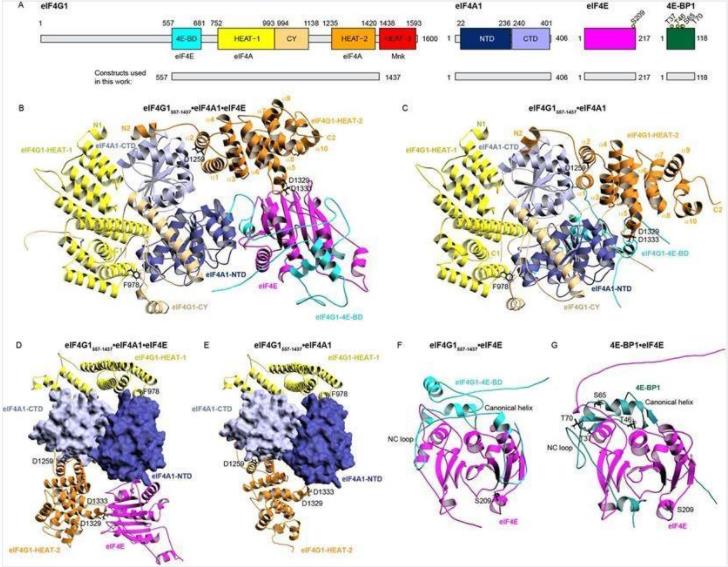What is EIF4G1 Protein
EIF4G1 is a key player in cellular protein synthesis and is of great significance to research in the fields of biomedicine and biotechnology.
EIF4G1 (eukaryotic translation initiation factor 4 gamma 1) is a multifunctional protein that is complexly integrated into the fabric of cellular translation initiation. At its core, EIF4G1 is a large and modular protein with multiple HEAT repeats that form a helical structure. These repeats play a critical role in mediating protein-protein interactions, demonstrating a role for EIF4G1 as a scaffolding protein in the translation initiation complex.
The Structure of EIF4G1
Understanding the complexity of EIF4G1 begins with its structural elements. The architecture of EIF4G1 consists of distinct domains, of which one notable eIF4E-binding domain (4E-BD) is responsible for its interaction with EIF4E. This interaction is key for the recruitment of the EIF4F complex to mRNA, a critical initial step in protein synthesis. The modular nature of EIF4G1 and its HEAT repeats and binding domains emphasize its adaptability in coordinating complex cellular processes.
 Figure 1. HEAT2 domain of eIF4G1 takes different conformations when eIF4G1 binds to eIF4E (Wu, S., et al. 2023)
Figure 1. HEAT2 domain of eIF4G1 takes different conformations when eIF4G1 binds to eIF4E (Wu, S., et al. 2023)The Function of EIF4G1 Protein
The main function of EIF4G1 lies in its role in the initiation phase of protein synthesis. As an important component of the EIF4F complex, EIF4G1 promotes the recruitment of ribosomes to mRNA, ensuring efficient translation of genetic information into functional proteins. In addition to its scaffolding function, EIF4G1 is actively involved in the regulation of mRNA scanning and unwinding, which is critical for smooth ribosome progression along the mRNA during translation initiation.
EIF4G1-Related Diseases
The link between EIF4G1 and neurodegenerative diseases, particularly Parkinson's disease, adds an additional layer of significance to its biological role. Genetic mutations in EIF4G1 have been identified in familial cases of Parkinson's disease, highlighting its potential involvement in disease pathogenesis. These mutations disrupt the normal function of EIF4G1, leading to impaired protein synthesis and the formation of toxic protein aggregates.
EIF4G1 Related Signaling Pathways
EIF4G1 is involved in signaling pathways, specifically the mTOR signaling pathway. Activation of mTOR phosphorylates EIF4G1, enhancing its interaction with EIF4E and promoting translation initiation. This mechanism links EIF4G1 to cellular nutritional and energy status, emphasizing its role as a sensor that regulates protein synthesis in response to environmental conditions. Furthermore, the involvement of EIF4G1 in integrated stress responses further emphasizes its adaptability in maintaining cellular homeostasis.
Applications of EIF4G1 in Biomedical Research
EIF4G1 has prospects beyond its fundamental role in cellular processes, providing valuable insights and applications for biomedical research.
- Neurodegenerative Diseases
Studying the role of EIF4G1 in neurodegenerative diseases reveals potential therapeutic targets. Understanding how disruption of EIF4G1 affects Parkinson's disease pathology lays the foundation for developing targeted interventions that address the underlying causes of neurodegeneration.
- Cancer
Dysregulation of translation initiation is a hallmark of cancer, making EIF4G1 a compelling subject in oncology research. Research targeting EIF4G1 in cancer may reveal the vulnerabilities of cancer cells, paving the way for the development of novel therapeutic strategies.
- Drug Development
EIF4G1 emerges as a potential target for drug development. Small molecules or compounds that modulate EIF4G1 activity could provide precise intervention in diseases where translation initiation plays a critical role, providing a new frontier in drug discovery.
- Biotechnology Applications
In biotechnology, understanding and manipulating EIF4G1 could improve protein production efficiency. Exploiting the role of EIF4G1 in translation initiation could optimize bioprocessing for therapeutic protein and enzyme production in industrial settings.
EIF4G1 transcends its role as a translation initiation factor and becomes a focus for unraveling the complexity of cellular processes and diseases. From its intricate structure to its impact on neurodegenerative diseases and applications in biomedical research, EIF4G1 is a promising subject for scientific exploration and therapeutic innovation.
Recommended Products for EIF4G1 Protein
| Cat.# | Species | Product name | Source (Host) | Tag |
|---|---|---|---|---|
| EIF4G1-01H | Human | Active Recombinant Human EIF4G1 protein, Myc/DDK-tagged | HEK293T | Myc/DDK |
| EIF4G1-28550TH | Human | Recombinant Human EIF4G1, GST-tagged | Wheat Germ | GST |
| EIF4G1-479H | Human | Recombinant Human EIF4G1 | Mammalian Cell | His |
| EIF4G1-12383H | Human | Recombinant Human EIF4G1 protein, His-tagged | E.coli | His |
| EIF4G1-2844H | Human | Recombinant Human EIF4G1 protein, His-B2M-JD & Myc-tagged | E.coli | His-B2M-JD & Myc |
| EIF4G1-02H | Human | Recombinant Human EIF4G1 protein, Myc/DDK-tagged | HEK293T | Myc/DDK |
| EIF4G1-477H | Human | Recombinant Human EIF4G1 Protein (1250-1599 aa), GST-tagged | E.coli | GST |
| EIF4G1-5398H | Human | Recombinant Human EIF4G1 Protein, Myc/DDK-tagged, C13 and N15-labeled | HEK293T | Myc/DDK |
| EIF4G1-1387H | Human | Recombinant Human EIF4G1 Protein (1250-1599 aa), His-tagged | Yeast | His |
| Eif4g1-2789M | Mouse | Recombinant Mouse Eif4g1 Protein, Myc/DDK-tagged | HEK293T | Myc/DDK |
Reference
- Wu, S., Wagner, G. Computational inference of eIF4F complex function and structure in human cancers. bioRxiv. 2023 Aug 11: 2023.08.10.552450.

